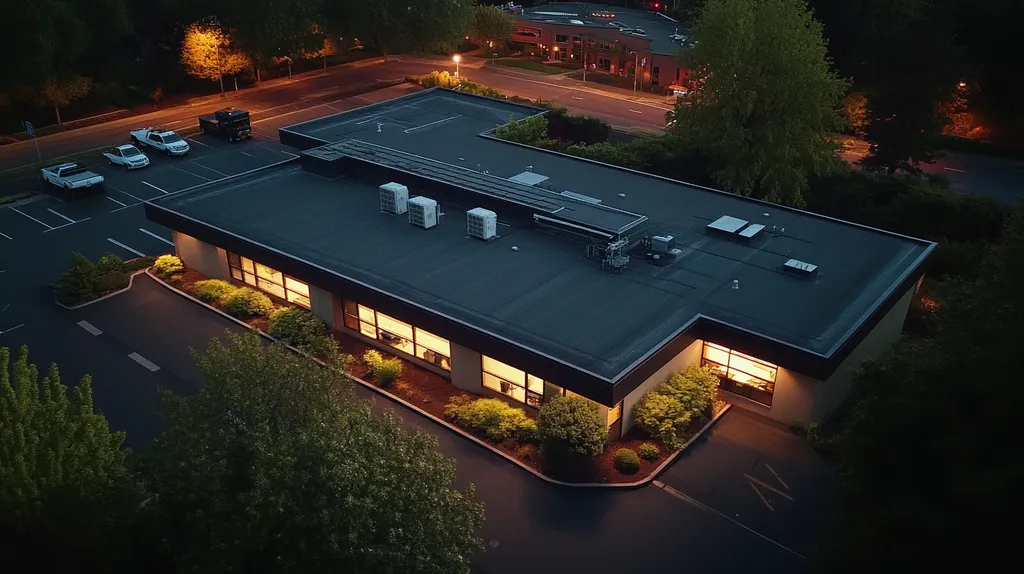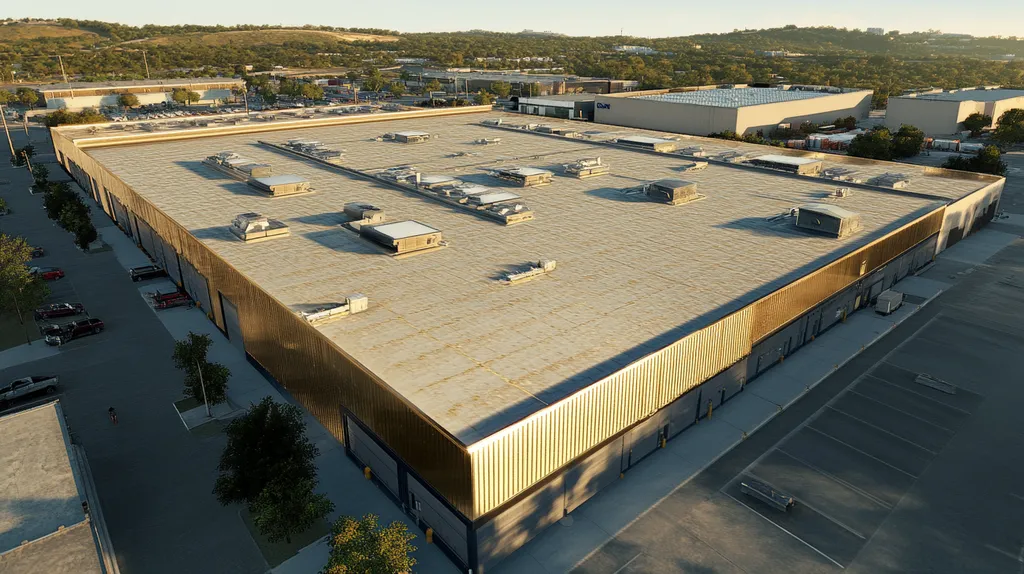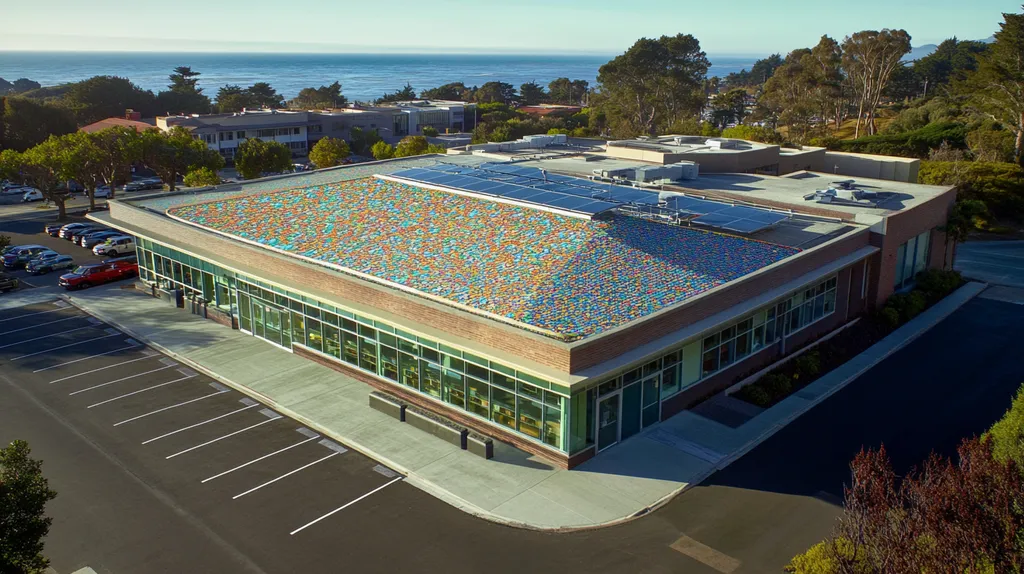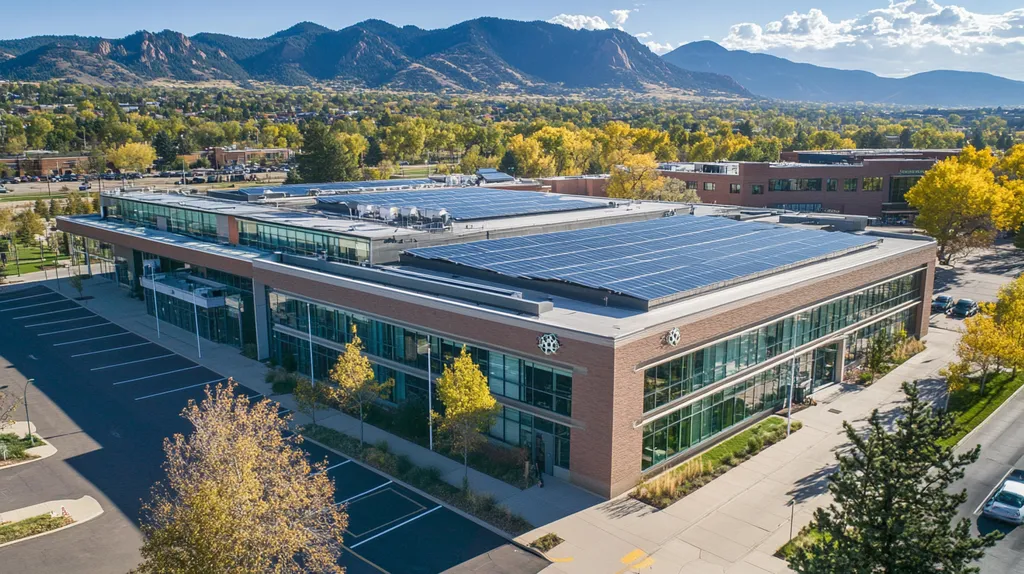Commercial property owners face a critical challenge: traditional roofing practices waste up to 40% of building energy through inefficient materials and poor installation. In 2023 alone, businesses lost over $12 billion due to excessive heating and cooling costs tied to subpar roofing systems.
While renewable energy solutions often dominate sustainability discussions, the most impactful approach begins with optimizing existing roof infrastructure through proven methods developed over decades of industrial experience.
This comprehensive guide examines time-tested strategies for reducing energy consumption through enhanced roofing practices, from material selection to long-term maintenance protocols that maximize efficiency while minimizing operational costs.
SECTION 1: FUNDAMENTAL CONCEPTS
As commercial properties face mounting energy costs and evolving regulations, the urgency to adopt energy-efficient roofing solutions cannot be overstated. A roof that fails to insulate properly can lead to substantial energy loss, potentially costing businesses thousands each year. This section will explore critical energy efficiency concepts, the dynamic relationship between climate and roofing systems, and the regulatory frameworks that shape these decisions.
Energy Efficiency Definitions
Energy efficiency in roofing is all about maximizing energy use while minimizing waste. This principle involves various factors, from the quality of insulation to the reflective capabilities of roofing materials. For instance, roofs with high thermal resistance can significantly reduce heating and cooling expenses.
Property owners should familiarize themselves with energy efficiency ratings, notably R-value and SRI (Solar Reflective Index). A higher R-value signifies better insulation, while a higher SRI means increased sunlight reflection, leading to reduced heat absorption. Understanding these metrics empowers facility managers to choose materials that align with energy objectives and budget limitations.
In a sector where energy expenditures can heavily influence financial outcomes, investing in energy-efficient roofing is a strategic move. Buildings featuring such roofs not only lower operational costs but also enhance their appeal by boasting reduced carbon footprints.
Additionally, energy-efficient roofing is critical for attaining sustainability certifications. These credentials can attract environmentally conscious tenants and boost property valuations. Thus, grasping the nuances of energy efficiency is vital for ensuring long-term profitability and environmental responsibility.
Climate and Roofing Interactions
The climate plays a pivotal role in determining the performance and lifespan of roofing materials. Varying temperatures, humidity, and weather patterns across regions must be factored into roofing choices. For example, roofs in warmer climates benefit from reflective materials that counteract heat, whereas those in colder regions require excellent insulation to hold in warmth.
Moreover, the impact of climate change brings additional challenges, such as heightened storm intensity and erratic weather. This variability demands robust roofing systems engineered to endure extreme conditions. An intelligently designed roof can alleviate the challenges posed by these climate-related stresses, thereby decreasing the need for frequent repairs or replacements.
Beyond protective functions, climate-appropriate roofing enhances energy efficiency. Cool roofs, which are crafted to reflect a larger portion of sunlight, help mitigate rising temperatures and diminish the urban heat island effect. The advantages extend beyond individual buildings to encompass entire communities, fostering better energy practices overall.
Consequently, understanding how climate interacts with roofing materials is essential for property owners. Informed decisions can lead to significant energy cost savings, extend roof lifespans, and positively contribute to the environment.
Regulatory Frameworks
The landscape of regulatory frameworks surrounding energy efficiency is rapidly evolving, directly impacting how commercial properties approach roofing solutions. Guidelines such as ASHRAE 90.1 establish minimum efficiency standards for buildings, necessitating that facility managers embrace energy-efficient practices. Non-compliance can result in increased operational expenses and potential legal ramifications.
Many states and municipalities provide incentives for businesses adopting eco-friendly roofing solutions. These incentives can help offset initial investments and encourage property owners to choose sustainable materials. Being informed about these opportunities can aid in financial planning and support long-term investment strategies.
By actively engaging with regulatory bodies, property owners not only ensure compliance but also enhance their commitment to sustainability. Participation in discussions around new codes or legislation allows facility managers to advocate for policies that serve their business interests while contributing to environmental preservation.
In summary, a comprehensive understanding of regulatory frameworks is crucial for commercial property owners. Aligning roofing strategies with prevailing laws mitigates risks and opens pathways for financial savings through available incentives and grants.
SECTION 2: SYSTEM COMPONENTS
The selection of materials in commercial roofing systems plays a pivotal role in minimizing reliance on renewable energy sources. An optimized roofing system not only enhances energy efficiency but also significantly lowers operational costs. For example, reflective roofing materials can cut energy consumption by as much as 30% in warmer climates. This section delves into critical components: reflective roofing materials, insulation and thermal resistance, and roof coatings and membranes, each essential for enhancing energy conservation.
Reflective Roofing Materials
Reflective roofing materials are engineered to bounce sunlight away, drastically reducing the temperature of the roof and subsequently lowering cooling expenses by up to 20%. By utilizing materials such as white or specially coated membranes, property owners can significantly boost their energy efficiency.
The color of a roof has a profound impact on energy consumption. Traditional dark roofing absorbs heat, resulting in heightened air conditioning requirements. Transitioning to reflective surfaces not only lowers energy costs but also prolongs the roof’s life.
Furthermore, reflective roofs aid in diminishing urban heat, which is increasingly concerning in densely populated areas. Lighter-colored roofs contribute to a cooler environment and help alleviate the heat island effect, ultimately benefiting local communities.
Investing in reflective materials may require a higher upfront cost, but the long-term savings and enhanced efficiency make it a prudent choice for property owners aiming to merge aesthetics with functionality.
Insulation and Thermal Resistance
Effective insulation is crucial for regulating a building’s temperature and decreasing reliance on artificial heating and cooling. High-quality insulation materials significantly improve thermal resistance, which is vital across varied climates. Buildings featuring superior insulation can experience energy cost reductions of up to 50%.
Insulation acts as an effective barrier against heat transfer, especially during extreme weather events. Facility managers should prioritize materials with elevated R-values, indicating greater resistance to heat flow—a particularly important consideration in regions with fluctuating temperatures.
Proper insulation not only leads to energy savings but also enhances occupant comfort and productivity. An adequately insulated building stabilizes temperature variations, promoting a more pleasant work environment.
Investing in durable insulation aligns with sustainability goals by reducing overall energy consumption, making it a smart choice for long-term operational efficiency.
Roof Coatings and Membranes
Roof coatings and membranes play a crucial role in extending the lifespan of roofing systems. These protective materials shield against UV rays, moisture, and severe weather, with high-performance coatings capable of increasing a roof’s longevity by over 10 years.
Applying quality membranes can prevent leaks and damage, thereby reducing maintenance costs significantly over time. Many property owners underestimate this aspect, yet regular maintenance can prevent costly repairs and compromised energy efficiency caused by leaks.
Additionally, reflective roof coatings complement insulation, further elevating energy efficiency. By reflecting sunlight, these coatings reduce roof temperatures, which helps decrease the demand for cooling inside the building.
Ultimately, selecting the appropriate coatings and membranes can translate into considerable savings and fewer replacements, making them essential components in the strategy to lessen reliance on renewable energy sources.
SECTION 3: IMPLEMENTATION METHODS
As energy costs rise and sustainability becomes a priority, commercial properties are urged to enhance energy efficiency. Buildings consume nearly 40% of the nation’s total energy, as reported by the U.S. Department of Energy. By strategically choosing materials, ensuring efficient ventilation, and selecting quality contractors, property owners can significantly reduce their reliance on renewable energy, enhancing both operational efficiency and cost-effectiveness.
Material Selection and Installation
Selecting the right materials is paramount for boosting energy efficiency in commercial roofs. Innovative solutions like cool roofing systems reflect sunlight and absorb less heat, lowering cooling expenses significantly. For instance, installing a reflective membrane can reduce rooftop temperatures by as much as 30 degrees Fahrenheit.
Durability is another critical consideration. Long-lasting materials such as TPO (Thermoplastic Olefin) or EPDM (Ethylene Propylene Diene Monomer) not only ensure effective waterproofing but also minimize the need for frequent replacements. This approach not only conserves resources but reduces long-term maintenance costs.
Moreover, the quality of installation cannot be overlooked. Partnering with experienced contractors who are well-versed in material performance and industry standards is essential. Proper installation guarantees that roofs will operate efficiently throughout their intended lifespan.
Regular evaluations of roofing needs can further enhance decision-making. Property owners should routinely assess material performance and durability, allowing them to make more informed choices regarding repairs or replacements when needed.
Ventilation and Moisture Control
Effective ventilation is vital for preventing moisture buildup beneath roofing materials. Poor ventilation can accelerate deterioration, leading to costly repairs and untimely replacements. A balanced ventilation strategy can maintain consistent building temperatures, which enhances energy efficiency.
Moisture control also plays a significant role in preventing health hazards such as mold growth and structural damage. Incorporating vapor barriers and appropriate insulation can effectively manage moisture levels, thereby prolonging the roof’s lifespan.
Additionally, installing ridge vents or exhaust fans can significantly improve air circulation. Enhanced airflow reduces heat accumulation, subsequently lowering air conditioning costs while ensuring a comfortable indoor climate.
Regular inspections of ventilation systems can help identify potential problems early, enabling proactive measures that avert expensive damage and associated repair costs.
Professional Contractor Criteria
Choosing a qualified roofing contractor is crucial for optimal roof performance. Contractors should have relevant licensing, adequate insurance, and proven experience with specific roofing systems. A reputable contractor typically has a solid history of successful installations.
Moreover, it is essential to select contractors who stay informed about industry trends and advancements. Inquiring about their knowledge of energy-efficient materials and compliance with local building codes can help ensure high-quality workmanship.
Gathering references and reading reviews can provide valuable insights into a contractor’s reliability. Authentic feedback from previous clients can guide property managers in making educated decisions about craftsmanship and customer service.
Finally, a robust warranty from contractors reflects their confidence in their work. A solid warranty not only protects the investment but also underscores the contractor’s commitment to delivering quality results.
SECTION 4: MAINTENANCE REQUIREMENTS
In the realm of commercial roofs, routine maintenance is not merely a best practice; it is a necessity that safeguards investments and bolsters energy efficiency. Evidence suggests that more than 30% of commercial roof failures result from inadequate upkeep, leading to costly damages and operational disruptions. Property owners must prioritize systematic inspections, timely repairs, and vigilant moisture management to extend the life of their roofs while minimizing energy-related costs.
Regular Inspection Protocols
Establishing a schedule for roof inspections is crucial in uncovering potential issues before they escalate. Experts recommend conducting these assessments at least four times a year, focusing on wear and tear, debris buildup, and any visible damage to materials. Each inspection should culminate in a detailed report that highlights vulnerabilities, ensuring energy efficiency remains a priority.
During these inspections, particular attention should be paid to seams and flashing, where leaks are most likely to occur. Additionally, a thorough check of drainage systems prevents water accumulation, which can lead to significant structural harm and inefficient energy use. The utilization of advanced technology, such as drone inspections, can provide a comprehensive overview and pinpoint problems that might be obscured from plain sight.
Proper documentation following each inspection serves as a helpful record, allowing property managers to track the roof’s condition over time. Adhering to these protocols not only extends the lifespan of the roof but also enhances energy efficiency, ultimately safeguarding operational reliability and reducing energy costs.
Repair and Replacement Strategies
A proactive approach to repairs is vital in preventing minor issues from escalating into larger, costlier dilemmas. Industry standards recommend addressing any detected damage promptly to ensure optimal roof performance and energy efficiency. Quick fixes today can save substantial amounts in future repairs and energy bills.
In terms of long-term maintenance planning, assessing the age and condition of the roof is critical. Property owners should be prepared for eventual replacements when repairs become frequent, keeping a comprehensive service history to inform future decisions. This foresight allows for more strategic budgeting and resource planning.
Choosing high-quality materials for repairs has a direct correlation to extending roof life and enhancing insulation. Employing durable roofing systems can effectively improve energy consumption and lower reliance on external energy sources. By adopting this proactive mindset towards repairs and replacements, facilities create resilient roofing systems that support sustainability efforts while protecting their investments.
Preventing Moisture-Related Issues
Moisture poses a significant threat to roof integrity, making preventative measures a top priority. Effective drainage systems are essential; they facilitate the removal of water and prevent accumulation, which can prompt structural damage and heightened energy expenses.
In addition, installing vapor barriers and ensuring proper insulation are crucial steps for preventing moisture infiltration within roofing systems. These practices not only improve temperature regulation but also contribute to longer roof lifespan and energy efficiency.
Regular maintenance tasks should include clearing gutters and downspouts to eliminate debris, as clogs can create water backup and potential leaks. Property owners must remain vigilant for signs of mold or mildew, which indicate moisture retention and require swift action.
By emphasizing moisture management, facilities can avoid expensive repairs while enhancing overall energy efficiency. Maintaining dry roofs supports reduced reliance on renewable energy sources and fosters a more sustainable operational framework.
SECTION 5: PERFORMANCE METRICS
In the quest to enhance energy efficiency in commercial roofs, understanding performance metrics is not just important—it is vital. The potential financial impact is significant: without proper monitoring, energy costs can skyrocket, with some buildings experiencing up to a 60% increase in energy expenses due to underperforming roofs. Therefore, focusing on three critical performance metrics—Solar Reflective Index (SRI), energy consumption monitoring, and evaluations of indoor comfort and air quality—is essential for informed decision-making.
Solar Reflective Index (SRI)
The Solar Reflective Index (SRI) serves as a cornerstone metric for any commercial roofing endeavor. It gauges a material’s efficiency in reflecting sunlight and minimizing heat absorption, playing a crucial role in cooling costs and energy savings. For example, white reflective roofing can lower surface temperatures by as much as 50°F compared to standard dark roofing.
When roofs have an SRI of 20 or below, they become less efficient, causing increased demand on air conditioning systems and escalating utility bills, particularly during the hot summer months. Selecting roofing materials with higher SRI ratings not only supports environmental goals but also translates to substantial cost savings.
Additionally, many local building codes are now enforcing higher SRI standards for new constructions, providing an opportunity for property owners to enhance both compliance and performance. By prioritizing roofing materials with elevated SRI values, facility managers can position their properties as leaders in energy efficiency.
Energy Consumption Monitoring
Continuous energy consumption monitoring is critical for gaining insights into a building’s energy dynamics. Advanced monitoring technologies allow property owners to track energy usage in real-time, revealing trends and identifying unusual spikes. For instance, understanding peak consumption times empowers facilities to devise strategies to lower energy use during high-cost periods.
Many organizations report reductions in energy expenses of up to 30% as a result of consistent monitoring. This statistic underscores the necessity of understanding energy patterns. By implementing smart meters and energy management systems, property owners can adopt informed strategies that decrease dependency on external energy resources.
Regularly assessing energy data enables facility managers to optimize HVAC settings and enhance overall energy efficiency. Furthermore, investing in energy monitoring systems can provide pathways to green certifications, thereby increasing property value and appeal.
Indoor Comfort and Air Quality
Indoor comfort and air quality are pivotal to employee productivity and satisfaction within commercial buildings. High temperatures or poor air quality can lead to absenteeism and low morale. Regular evaluations of these factors can pinpoint deficiencies related to roofing and overall building performance.
For example, a roof that lacks adequate ventilation may trap heat and moisture, creating uncomfortable conditions and posing health risks. By systematically monitoring these indoor environments, facility managers can ensure optimal air quality and effective temperature regulation.
When management prioritizes metrics related to indoor comfort, positive outcomes typically emerge. Research shows that improved air quality can enhance worker productivity by up to 15%. This vital connection between roofing performance and employee satisfaction becomes apparent, illustrating the significant benefits of addressing indoor conditions.
Additionally, tending to indoor environment metrics enhances a facility’s reputation, making it more inviting to potential tenants and employees. Thus, incorporating regular assessments of comfort and air quality into maintenance plans can lead to happier occupants and decreased operational costs.
SECTION 5: PERFORMANCE METRICS
In today’s energy-conscious landscape, performance metrics for commercial roofs are not just technical details—they are essential indicators of operational success and financial sustainability. Failing to monitor these metrics can lead to significant financial repercussions; energy costs can surge by over 60% if roofs are not functioning at their best. Key metrics to focus on include the Solar Reflective Index (SRI), energy consumption monitoring, and evaluations of indoor comfort and air quality.
Solar Reflective Index (SRI)
The Solar Reflective Index (SRI) is a fundamental metric in optimizing commercial roofing solutions. It quantifies how effectively roofing materials reflect sunlight and minimize heat absorption, attributes that directly impact cooling costs. For example, a white reflective roof can maintain temperatures up to 50°F cooler than traditional black roofs, leading to substantial energy savings.
When roofs have an SRI rating of 20 or below, their inefficiency forces air conditioning systems to work harder, driving up energy bills, particularly during hot summer months. By opting for materials with higher SRI ratings, property owners can achieve significant cost reductions while supporting environmental goals.
It’s also worth noting that many local building codes now require higher SRI values for new constructions. Embracing this regulatory shift can not only elevate building performance but also enhance competitiveness in the market.
Ultimately, focusing on roofing materials with advantageous SRI ratings allows facility managers to position their properties as front-runners in energy efficiency.
Energy Consumption Monitoring
Constant energy consumption monitoring is indispensable for understanding a commercial building’s energy usage patterns. Advanced monitoring systems empower property owners to track energy consumption in real time, revealing trends and highlighting irregular spikes. By identifying peak usage times, facilities can craft strategies to drive down consumption during high-cost periods.
Organizations using continuous monitoring often report energy savings of up to 30%, reiterating the importance of understanding energy dynamics. Integrating smart meters and energy management software equips property owners with insights to make educated choices that lessen their dependence on external energy sources.
Facility managers should routinely analyze energy data, adjusting HVAC settings and optimizing energy patterns. Furthermore, investing in robust energy monitoring systems can lead to green certifications, boosting the property’s market value and attractiveness.
In summary, effective energy monitoring transforms roofs from passive structures into proactive contributors to energy management.
Indoor Comfort and Air Quality
Indoor comfort and air quality are critical factors influencing employee productivity and overall satisfaction within commercial spaces. Extreme temperatures or subpar air quality can lead to increased absenteeism and diminished morale. Regular assessments of these factors can help identify shortcomings potentially linked to roofing issues.
For example, roofs that lack proper ventilation may trap heat and moisture, creating uncomfortable and potentially hazardous indoor conditions. Systematic monitoring ensures optimal indoor environments and efficient temperature control systems.
When management prioritizes metrics related to indoor comfort, improvements in employee well-being and output often follow. Research indicates that enhanced air quality can result in up to a 15% increase in worker productivity, demonstrating a clear link between roofing performance and occupant satisfaction.
Additionally, fostering better indoor conditions elevates a facility’s reputation, making it more appealing to potential tenants and employees. Consequently, incorporating regular evaluations of comfort and air quality into maintenance plans leads to happier occupants and significant long-term savings.
Moving Forward
The stark reality is that inefficient commercial roofs waste over $40 billion in energy costs annually across North America – a figure that continues to rise with increasing energy prices.
While renewable energy solutions garner attention, the most impactful approach remains optimizing existing roof infrastructure through proven methods like reflective materials, strategic insulation, and systematic maintenance.
The evolution from traditional built-up roofing to modern synthetic systems demonstrates how far commercial roofing has progressed in energy efficiency.
By implementing the strategies outlined in this guide, property owners can reduce energy consumption by 30-50% while extending roof lifespans by up to 15 years.
The time for action is now – every day of delay means more wasted energy and unnecessary costs that directly impact the bottom line.
FREQUENTLY ASKED QUESTIONS
Q. What is energy efficiency for commercial roofs?
A. Energy efficiency in roofing involves using materials that maximize energy use while minimizing waste. Roofs with higher thermal resistance and reflective capabilities can significantly cut heating and cooling costs, leading to better financial outcomes for property owners.
Q. How do reflective roofing materials benefit industrial roofs?
A. Reflective roofing materials help lower surface temperatures by bouncing sunlight away, which can drastically cut cooling costs. Transitioning from dark roofs to reflective ones not only saves energy but prolongs the roof’s lifespan, aligning aesthetics with functionality.
Q. What strategies improve commercial roof energy efficiency?
A. Selecting high-performance materials, ensuring proper ventilation, and collaborating with experience contractors are pivotal strategies. Regular evaluations and maintenance of roofing systems are also essential to enhance energy efficiency and minimize reliance on outside resources.
Q. How often should commercial roofs be inspected?
A. It is recommended to conduct roof inspections at least four times a year. These assessments help identify wear, debris, and damage early on, allowing property owners to maintain energy efficiency and prevent costly repairs from escalating issues.
Q. What is the Solar Reflective Index (SRI) for roofs?
A. The Solar Reflective Index quantifies a roof’s ability to reflect sunlight and minimize heat absorption. Higher SRI values indicate better performance, which helps reduce cooling costs and supports regulatory compliance, positioning properties favorably in energy efficiency discussions.
Q. How can moisture management impact commercial roofing?
A. Effective moisture management is crucial for maintaining roof integrity. Installing vapor barriers and ensuring proper drainage can prevent leaks, mold growth, and structural damage, ultimately enhancing energy efficiency and reducing reliance on renewable energy sources.
Q. What metrics should be used to assess roof performance?
A. Key performance metrics include Solar Reflective Index, energy consumption monitoring, and evaluations of indoor air quality. Regularly analyzing these metrics helps ensure that roofing systems perform efficiently, providing financial benefits and improving occupant comfort.











